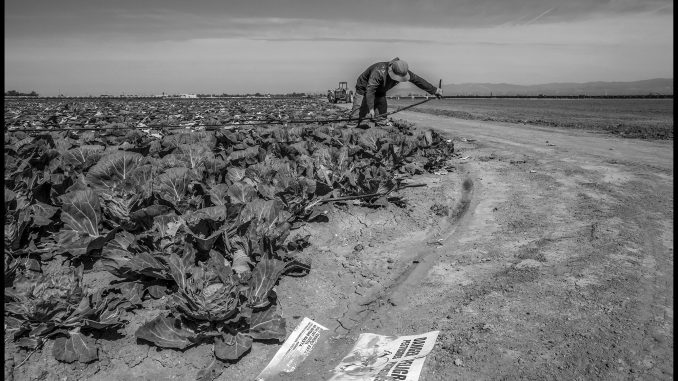
By David Bacon
This story is produced by the award-winning journalism nonprofit Capital & Main, as part of its Ill Harvest series, and co-published here with permission.
In the summer of 2008, Andres Cruz got a call from a crew of Triqui workers picking peas near Greenfield, a farmworker town in California’s Salinas Valley. They told him they were on strike, and because he’s a leader in their community, they asked him for help. Twenty-five pickers had been fired, they said.
“They told me the labor contractor fired them because they were working on a piece rate and weren’t picking fast enough,” recalls Cruz, who himself works as a broccoli cutter. Pickers have to use their thumbnails to cut the pod from the vine. “Their nails were tearing off because of this. They tried to wrap up their hands and keep working, but they couldn’t work as fast, and the foreman wouldn’t listen to them.”
Triquis are Indigenous people from small villages in the hills of Oaxaca, Mexico, speaking a language that predates European colonization by centuries. Thousands have migrated to the U.S. in search of work, and they have a prominent presence in Greenfield. Almost all work in the fields, and their families in Mexico depend for survival on remittances sent back from their wages.
Cruz and organizers for the United Farm Workers met with the Triqui pickers. They explained they had the right to complain to the California Division of Occupational Safety and Health, the state agency responsible for enforcing laws pertaining to workplace safety, and could get treatment and workers compensation pay. Cruz said the landowner called the sheriff, however, who confronted the workers and organizers at the field.
“When the contractor saw the union was there,” Cruz says, “he agreed to let the fired people go back to work. I told them they could get time off so their hands could heal, but they said they couldn’t afford to lose a day of work. So they went back.”
Their work stoppage was powerful enough to win reinstatement for those terminated. But the pressure of families in Mexico who need remittances, and the low wages paid for farm work, was a potent combination. Even when the pickers learned about their legal rights to medical treatment and some degree of compensation, the need to keep working overrode their ability to exercise those rights.
Multiple studies document the high rate of illness and injury for field laborers. According to Farmworker Justice, a Washington advocacy group, “Agricultural injuries and illnesses take many forms from falls, cuts, and lifting injuries to chemical exposures, vehicle and machinery accidents, and even chronic pain associated with repetitive movement. … These conditions disproportionately affect migrant and seasonal farmworkers … .”
The U.S. Department of Labor says that in 2020 589 farmworkers died at work. Official sources have historically undercounted workplace illness and injuries, however. The Bureau of Labor Statistics estimated that there were 32,100 illnesses and injuries among U.S. farmworkers in 2011. But it left out workers employed by labor contractors (in California, 55 percent of the farmworker workforce) and didn’t account for nonreported cases. When health economists at the University of California, Davis reexamined the data, “the estimated number of job-related injuries and illnesses experienced by agricultural workers … rises to 143,436,” their study concluded.
Surveys of farmworker health are rare. According to a 1998 California farm survey of occupational injuries and hazards in Monterey and Fresno counties, “29 percent of the workers reported occupational injuries associated with farm work, farm equipment or transportation. Among the injured workers, 20 percent reported multiple incidents, [and] 27 percent missed at least one day of work … .” Less than half got any medical care.
‘Power imbalance’
Farmworkers in California have important legal protections for their safety and health at work, won through decades of advocacy. The state has a workers compensation system that should guarantee treatment and some replacement wages for those who do get sick or injured on the job. But according to Garrett Brown, who spent 18 years as a field inspector for Cal/OSHA, and two as the special assistant to the agency’s director, “the power imbalance between workers and employers in agriculture is much greater than almost any other industry. That determines what happens to farmworkers in real life.”
Cruz’s wife, Catalina, had difficulty using the workers comp system when she was hit by a ladder on a machine that packs broccoli in the field. Although the pain was enough to make her cry, she didn’t tell the foreman right away and kept working. “I was afraid to lose pay, or that I might get fired,” she recalls. Finally, when the pain was too much, she went to the emergency room at the local hospital, which sent her to a community clinic. “The doctor told me I could go back to work the next day. And when I asked about workers compensation, the foreman said they weren’t responsible because I’d waited two days to tell them.”
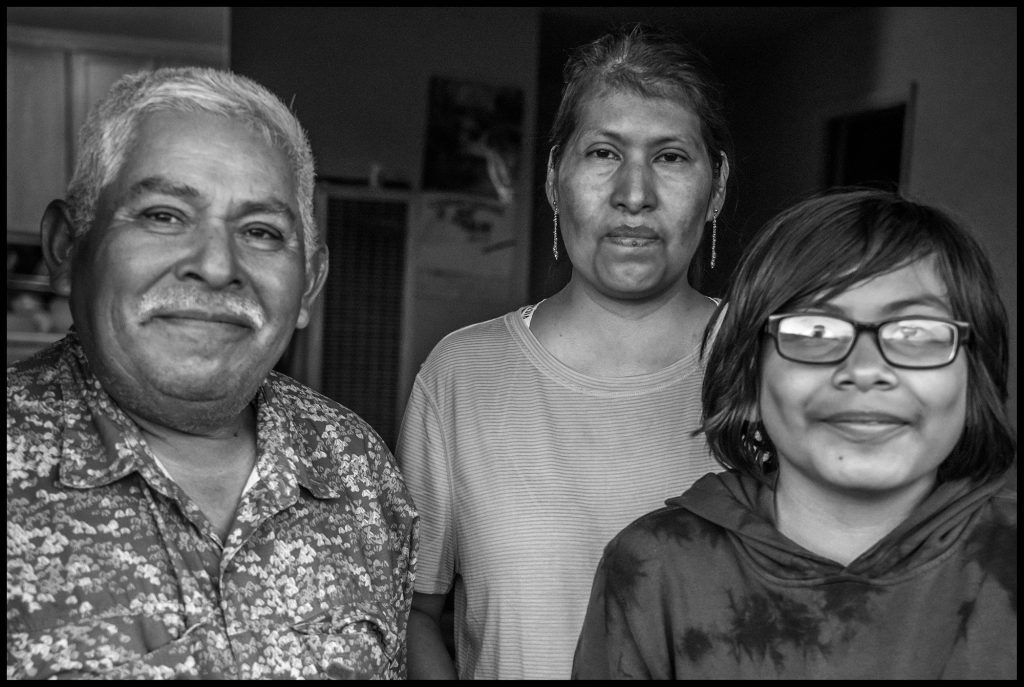
Juvenal Solano, senior community organizer for the Mixteco Indigena Community Organizing Project, says that Catalina Cruz’s experience is common because companies pay less for workers compensation insurance if workers don’t make claims. “They tell workers that if they notify the company a day or two after an injury they’ll be disciplined,” he explains. “But when you’re working your body is warmer and in that moment you don’t always feel as much pain. Then, if you feel it later and complain, the foreman says he’ll give you a warning because you didn’t report it right away. So the worker keeps on working.”
Getting released from work is particularly difficult for pregnant women. “Indigenous women often lose their babies in the first two or three months,” Solano charges. “In the strawberries women have to work bent over double all day, and lift heavy boxes every few minutes. That can cause injuries even without being pregnant, but once women are 3 or 4 months along, it’s dangerous. If they ask for disability benefits so they can stop working, a doctor who thinks working in the field is like working in an office often tells them that pregnancy isn’t a disability. Some women, when they’re denied benefits, decide to stop working anyway. But most can’t survive economically if they don’t work.”
Among strawberry pickers, back pain and injury is endemic, but going to the doctor usually means taking off work and making an advance appointment. “If the pain is intense they can’t wait, so they go to a solvador [a traditional massage therapist] recommended by someone in the community,” he explains. “Those who know their rights might make a report and open a case, but most don’t. They take pills and keep working.”
Lauro Barajas, regional director in Salinas for the United Farm Workers, emphasizes that “in the strawberries people have to work bent double, year after year. After 15 or 20 years it’s clear that the resulting injuries are from work. But when workers complain they’re sent to the company’s doctor who often sends them back to work right away. The doctors are almost worse than the foremen. And if a worker makes a claim for workers compensation, the company has lawyers, a human resource department, supervisors and doctors. How can one farmworker overcome all of that?”
Anne Katten, legislative advocate for the California Rural Legal Assistance Foundation and director of its pesticide and worker safety project, agrees. “The workers comp system is very bureaucratic and daunting. For anyone with a problem like a back or shoulder injury, it’s hard to get diagnosis and treatment. But farm work is seasonal, and those known to have an injury are less likely to be hired for the next season. Most will work with back pain or respiratory problems because they only have a few weeks of work to begin with.”
Toxic conditions
Pesticide exposure is an acute problem for field laborers, who can experience effects ranging from nausea, vomiting and headaches to fainting, seizures and even death. Some pesticides are known causes of cancer, neurological disorders and birth defects, especially from chronic exposure over years of work. Yet despite EPA estimates that 3,000 workers every year suffer from pesticide poisoning, there is no national tracking system for cases.
“In Santa Maria I got a call that a boy from Oaxaca was sick,” Barajas recalls. “He had just come from work, and I found him lying on the floor in convulsions. That morning he’d started working in a field where pesticides were applied the day before. He began to vomit and couldn’t keep working. With no way to leave, he stayed in a car at the edge of the field until work ended that afternoon. I called an ambulance. The company then told the hospital they weren’t responsible and the worker would have to pay for his treatment. That happens a lot in pesticide injuries.”
For a contested claim like this, a worker can appeal a denial of the workers compensation benefits that should pay for medical expenses and a percentage of lost wages. “You’re supposed to be able to get an attorney,” Katten says. “But most don’t want to take challenging cases where a settlement is uncertain, especially pesticide illnesses. There should be a simpler way for people to get care. The system is very broken.”
While the cause of illness in acute poisoning cases can be obvious, it’s harder for workers to get recognition for more chronic problems. “I’ve seen pesticide illness reports,” Brown says, “where doctors say workers are just responding to smells or are having psychological reactions. Often there’s no thorough analysis of what caused the exposure. In community clinics, where farmworkers are most likely to go for treatment, few staff are able to identify pesticide illnesses. We really need people trained in occupational medicine, and to keep medical histories of what people are exposed to.”
That long-term perspective is critical in tracking the impact of pesticide exposure on whole communities. A 2010 UC Davis survey found “an elevated prevalence of indicators of chronic disease, but lack of health care access.”
In Oxnard, Solano says the Mixteco community has seen an increase in cancer and birth defects. “When people come to the U.S. their kids born here have autism, and people die of cancer,” he explains. “Our home towns in Oaxaca don’t have these problems. We don’t have studies but we suspect that it’s because of the chemicals. Yet people here have to work, and the workers comp system doesn’t provide health care access for this.”
Compounded by COVID
The pandemic added another layer of hazard for farmworkers. In rural counties the raging virus produced infection rates more than twice those of urban counties. According to a report by the California Institute for Rural Studies, between March and June of 2020 agricultural workers in Monterey County contracted COVID-19 at three times the rate of workers in other industries.
Farmworkers were particularly impacted by the coronavirus, he says, in part because of a breakdown in Cal/OSHA’s system of enforcement. According to Garrett Brown, “In the first year there were 9,000 complaints, but for most of 2020 there were very few onsite inspections. There weren’t enough inspectors, and many were unwilling or unable to go into the fields. Instead, they sent letters to employers asking them to report any incidents by mail. Farmworkers, however, continued to go to work, and this left them at risk.”
Maggie Robbins was an occupational and environmental health specialist for Worksafe, a nonprofit worker advocacy group, during that period. She helped negotiate a new standard for keeping workers safe. As in Washington state (see Capital and Main, “Are Washington’s Farmworkers COVID-19 Guinea Pigs”) a conflict quickly developed between growers and unions over transportation and housing regulations.
“The basic consideration for all migrant workers was to keep safe distances between people in the motels and labor camps, and on buses taking workers to and from the fields,” she explains. “Labor contractors, transport companies and growers all said regulations weren’t necessary because compliance would cost them money. But in November the board adopted a standard requiring a six-foot separation. That was a good step, and beyond what other states were requiring. The problem, as always, was the lack of enforcement.”
At Primex Farms, a pistachio grower in Wasco in the San Joaquin Valley, 150 workers had tested positive for the virus by July of 2020. When many stopped showing up for work, the company said they were on vacation. By the time it admitted that workers were getting sick, many had brought the virus home to their families. In July Primex employee Maria Hortencia Lopez died and another worker was taken off life support. Yet knowing the risk, some laborers went to work anyway because the company wouldn’t pay for time off to quarantine.
The UFW helped Primex workers organize a strike to force the company to comply with the federal law mandating paid leave for COVID victims. Ultimately, Primex agreed to follow the law and to rehire contract workers it had terminated when they protested the lack of COVID protections. But the company then laid off 60 workers while hiring replacements. Primex told the Grist website that it “worked hard to protect and support employees through the crisis.”
Cal/OSHA fined Primex $27,500 following publicity from the strike and demonstrations, including a $5,000 penalty for not reporting two cases. Its labor contractors were also fined. Advocates say such enforcement is ineffective because for large companies such penalties are a small cost of doing business.
“Cal/OSHA had around two hundred inspectors for 9,000 complaints,” Brown charges. “The failure of enforcement, not just for COVID but for other work-related problems, meant that more workers got sick and needed greater access to health care. Since farmworkers historically have access problems, their health conditions deteriorated.”
During 2020 the Legislature passed bills to meet the crisis, including measures for bilingual campaigns to educate workers, coronavirus sick leave and workers compensation benefits, and improved access to medical care through telehealth services. But the enforcement crisis grew worse. The 84 unfilled positions at Cal/OSHA before the pandemic became 130 by mid-2020. Brown says the number of unfilled field inspector positions is now 60, and will grow by an additional 24 in January.
According to a UCLA study, at the beginning of the pandemic 79 percent of California’s undocumented workers were employed in industries deemed “essential,” including agriculture. The Migration Policy Institute estimates that 156,000 undocumented people worked in the state’s agriculture industry in 2019.
“Immigration reform would therefore make workers healthier as well,” Brown says. “In my experience doing field worksite inspections, undocumented workers avoided anything that might result in them getting reported to immigration authorities and being deported. That includes reporting illnesses and injuries, and getting treatment for them.”
Overcoming barriers
Making complaints and getting care is easier and safer for farmworkers in a union workplace, including the undocumented. “If a worker has a problem,” Barajas says, “he or she calls us. We go to the company, ask for a report, and send the person to a doctor. The company doesn’t hide the problem, and we educate people so they know their rights. If someone has a lot of pain and still needs to work, we ask the company to give them a less demanding job.”
Worksafe’s Robbins calls this the union effect. In bargaining a union contract, workers can advocate changes to make work safer and healthier and improve their health care access. “Legislated standards give them credibility,” she says, “but changes in a workplace happen when workers have a way to get their employers to implement them. You need organized workers for this.”
Given the low wages in agriculture, however, health and safety changes and health care access are not always worker priorities. Solano describes work stoppages organized by Santa Maria strawberry pickers at the beginning of the 2022 season. Most were in their 20s and 30s, he says. “Their main demand was raising the wages, along with cleaner bathrooms and better drinking water. Because they’re young they weren’t thinking much about the impact of the next 15 or 20 years of work.”
To lessen the stress on workers’ bodies, Barajas says, the union included in its strawberry growers contract an agreement to give workers the option of resting every hour and a half — more frequently than legally required. “But there’s such economic pressure from rent and food bills, plus sending money home, that most workers just worked through the break,” he says.
The attitude of strawberry pickers is like that of the Triqui workers losing their thumbnails — earning enough money to survive is the overriding necessity. “We need to build their awareness that they won’t always be young,” Solano says. “They need to think about working with dignity, work that won’t put their bodies in danger.”
In the early 1960s, that logic impelled California Rural Legal Assistance and the nascent farmworkers union to push the state to ban the “cortito” — the short-handled hoe. The long-term use of this tool, which forced workers to bend over double to thin lettuce and other row crops, led to widespread spinal injuries. California became the first state to prohibit its use. Farmworkers’ need for better access to health care continued, while the cortito’s elimination improved their health and made that need more manageable.
Changing the work in strawberry fields might have the same impact, since laborers have to bend over much as they did using the short-handled hoe. Getting rid of the cortito was relatively easy and cheap, however, since it just required substituting a long handle for a short one. “Changing the way strawberries are picked would be much harder,” Barajas says. “Some growers now are beginning to change the structure of the rows, making the beds higher and covering them with rubber. But that’s very expensive, and smaller growers can’t do it.”
In strawberry picking, like many jobs in agriculture, workers get paid for the amount they pick. “This system is the key to why people kill themselves,” Barajas says, “but workers don’t want an hourly wage because the minimum is so low. A much higher hourly wage would ease that pressure. But if the companies would just raise the price they pay per box from $2 or $2.10 to $2.30 or $2.40 people would be able to rest more. We need to look for ways workers can make enough so they don’t have to mistreat their own bodies, and their access to health care doesn’t have to be such a crisis.”

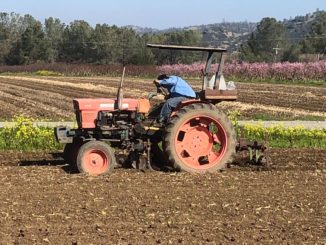
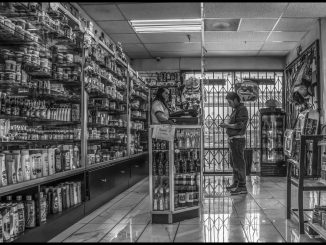
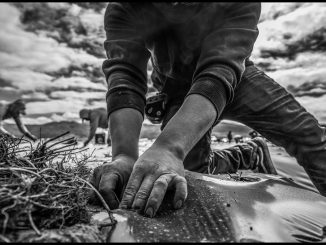
Be the first to comment